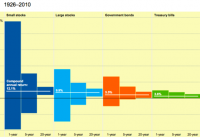Asset Values And Valuation
What’s a stock worth? “The market is overvalued.” “No, it’s fair.” “No, you’re missing the point – the economy has changed.” “What? Are saying it’s different this time?” “It’s always different.” Arguments over stock-market valuation have been around ever since stocks have traded. In many ways, the purpose of an open stock market is to discover what the clearing price for a company should be – what price satisfies both the buyers and sellers of a company’s shares. But just knowing something’s price doesn’t tell you what it’s worth. As Warren Buffett is fond of saying , “price is what you pay, value is what you get.” There are two general ways to value an asset: bottom-up, fundamental analysis that focusses on the present value of expected cash flows; and top-down, relative-value analysis that looks at the entire market and the range of investment alternatives. The first examines a specific company; the second evaluates an entire industry – or even the whole economy. Any economic asset generates cash over time. This cash flow can be forecasted, and the results discounted to present value. With bonds, this is fairly straightforward; the cash-flow is contractual. With stocks earnings can be more volatile, but they can also grow over time. We compensate for this by increasing the discount rate. Lower risk means a lower interest rate. Net present value formula. Source: Wikipedia The top-down approach looks at any asset and asks, “Compared to what?” So we use various financial ratios – price/earnings, price-to-book, enterprise value over free cash flow. With bonds, we focus on the “spread” – their level of yield above comparable risk-free government bonds. By checking what else is out there – playing the field – investors can see how what they own looks relative to everything else. Map of S&P 500 PE ratios. Source: Financial Visualization Both methods have their merits: bottom-up analysis generates an intrinsic value – something that is fairly stable over time. Top-down valuation looks at the range of investment alternatives. No investment, after all, is an island. But folks who only focus on bottom-up analysis can get distracted by the details and miss the forest for the trees. Top-down studies can be too volatile: the world may always be changing, but it doesn’t change that much from day to day. And human nature never really changes. Financial analysis tries to answer the question of what an asset is really worth. It’s a good question. In the end, though, a stock is only worth what someone else is willing to pay for it.
